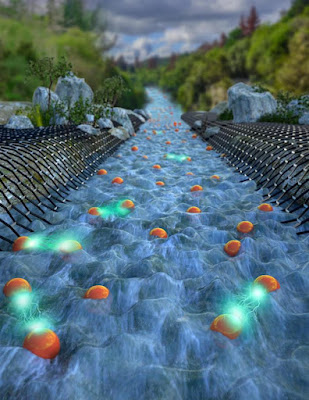 |
| A river made of graphene with the electrons flowing like water. Courtesy: Ryan Allen and Peter Allen, Second Bay Studios |
Topics: Electron Configuration, Graphene, Nanotechnology
Electrons can behave like a viscous liquid as they travel through a conducting material, producing a spatial pattern that resembles water flowing through a pipe. So say researchers in Israel and the UK who have succeeded in imaging this hydrodynamic flow pattern for the first time using a novel scanning probe technique. The result will aid developers of future electronic devices, especially those based on 2D materials like graphene in which electron hydrodynamics is important.
We are all familiar with the distinctive patterns formed by water flowing in a river or stream. When the water encounters an obstacle – such as the river bank or a boat – the patterns change. The same should hold true for electron flow in a solid if the interactions between electrons are strong. This rarely occurs under normal conditions, however, since electrons tend to collide with defects and impurities in the material they travel through, rather than with each other.
Making electrons hydrodynamic
Conversely, if a material is made very clean and cooled to low temperatures, it follows that electrons should travel across it unperturbed until they collide with its edges and walls. The resulting ballistic transport allows electrons to flow with a uniform current distribution because they move at the same rate near the walls as at the center of the material.
If the temperature of this material is then increased, the electrons can begin to interact. In principle, they will then scatter off each other more frequently than they collide with the walls. In this highly interacting, hydrodynamic regime, the electrons should flow faster near the center of a channel and slower near its walls – the same way that water behaves when it flows through a pipe.
Electrons flow like water in ultra-pure graphene, Belle Dumé, Physics World
Comments